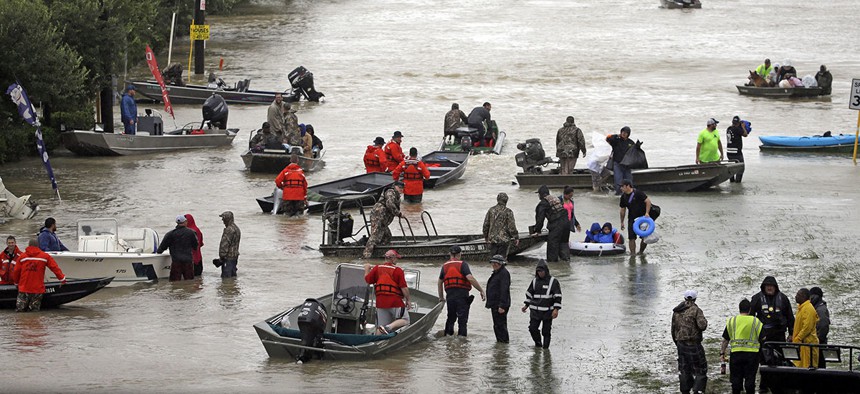How Technology Can Help Mitigate Hurricane Harvey-Like Disasters

Rescue boats fill Tidwell Road as they help flood victims evacuate as floodwaters from Tropical Storm Harvey rise Monday, Aug. 28, 2017, in Houston. David J. Phillip/AP
Well-placed backup and recovery systems can help keep government systems running.
John Breeden II is an award-winning journalist and reviewer with over 20 years of experience covering technology. He is the CEO of the Tech Writers Bureau, a group that creates technological thought leadership content for organizations of all sizes. Twitter: @LabGuys
Unfortunately, we don’t yet have technology that can prevent a storm of the magnitude of Hurricane Harvey from devastating our cities and towns. But it can help in the response, and even provide valuable information for citizens trying to survive a catastrophic event.
One key is properly locating backup and recovery systems for government agencies. Typically, most cities and towns with a backup plan for their data rely on nearby data centers. That’s fine if there is a fire at the local office building or something that forces the temporary closure of government buildings. However, these local backups are far less effective in dealing with events like Harvey, where an entire city or an even larger geographic area is damaged or destroyed. A Department of Homeland Security report issued after Superstorm Sandy cited this as one potential weakness in most government backup plans. There were towns in New Jersey that had both their main data centers and their backups flooded or otherwise destroyed by the storm.
» Get the best federal technology news and ideas delivered right to your inbox. Sign up here.
Part of the problem with a state like New Jersey attempting to do offsite backup within its borders is its size. Having the main data center in Trenton backed-up in Newark might not offer enough separation for a major weather event or another disaster. In that, Texas is a little better positioned, able to house its backups well inland from its coastal cities.
The federal government goes even further than that with its critical assets. As part of its $4.6 billion Global Information Grid Services Management Operation aimed at modernizing Defense Department communications and networks, several Defense Information Systems Agency network centers around the world were consolidated into just two facilities. Though the facilities mirror each other in capabilities, one is located in Hawaii while the second is in Illinois. The main reason for the distance between the two facilities is to prevent any one disaster from crippling Defense networks. It’s almost inconceivable outside of an extinction life event for any disaster to endanger Illinois and Hawaii at the same time.
But even state and local governments can get that same type of protection these days thanks to cloud computing. Backing up data to the cloud is an incredibly straightforward process these days, with every major cloud service provider offering this service for government organizations. And I have recently reviewed several programs designed to offer easy cloud backups for smaller, potentially less technically savvy organizations like local governments or schools. Nobody, especially government organizations, should be able to plead poverty or lack of technical knowledge as a barrier to starting a cloud backup program.
With cloud services, any city or town can have its primary backup servers located across the country, ready to provide communication and other services to crews on the scene responding to any disaster, as well as to smartphone-equipped residents looking for help.
The Homeland Security report from Sandy also recommended that government begin to rely more heavily on another cloud-ready service during every phase of a disaster: social media. Non-governmental organizations have already started doing this, especially after being blindsided by Hurricane Katrina back in 2005. At the time, the report notes that well-meaning groups put up websites to try and help survivors of that disaster find help, but their efforts were uncoordinated and it was difficult for people to find useful information relevant to their specific situation. Today, most nonprofits coordinate their efforts in a few central locations, which are often linked to official government websites.
What governments at all levels need to do is to mirror this approach, and tie it to cloud computing and backup efforts. It’s entirely possible today for a government agency or municipality being hit by a disaster to maintain its online operations and provide information and assistance to its residents even if its main facilities are flooded or otherwise destroyed. It just requires the preparation of cloud backups and the establishment of official information channels, like through social media, well before the potentially catastrophic event.
While some of these things were done before, during and after Hurricane Harvey, it’s clear that the process has not yet been completely streamlined. With seemingly more violent weather and stronger storms ravaging our world every year, this effort is not something that should be put aside or delayed. By the time we learn about the next potentially devastating hurricane, tornado, blizzard, superstorm, earthquake, wildfire or other disaster heading toward our town, it will already be far too late.






